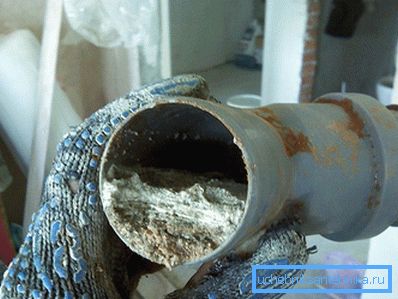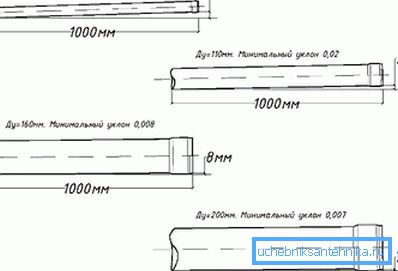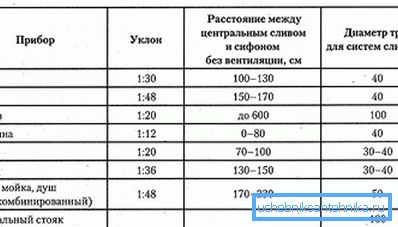What is the slope of the sewer pipe should be
When repairing an apartment, building your own house, the new engineering systems are replaced or laid, including sewage systems. A simple, at first glance, task with the wrong approach can interfere with the functioning of the wastewater disposal system. Many repairmen and homeowners do not know what slope of the sewer pipe should be in the apartment and private house, and assemble it on the basis of their own intuition. In this article we will tell about the angle of inclination of the sewer pipe according to SNIP.
Avoid mistakes

It is very important to establish the correct slope of sewage pipes so that all drains and waste by gravity reach the place of their disposal. An insufficient increase in the level of entry into the system compared to the output can lead to a delay in the solid and heavy components in the pipe.
Fat deposits on the walls will contribute to clogging. If the pipes are strongly tilted, the liquid fraction will leave too quickly, leaving heavy particles on the bottom of the pipes. As a result of gradual accumulation, blockage will occur. In addition, the rapid flow of fluid will create an overpressure, which will lead to the appearance of an air wave with the release of an unpleasant odor. Sections of the sewer network are recommended to be straightforward, this is important, because in places where corners are located, congestion often occurs.
The parameters and requirements for the drainage network inside and outside the premises differ. They are governed by the relevant regulations - building regulations.
Simple ways to calculate the angle

In the subsequent subsections of this article, all the necessary formulas and values for rigorous calculations are given. They will be necessary in cases where the construction of an industrial site is planned, or one where an inspection will then be carried out by the relevant services for commissioning. At home, enough to remember a few simple rules. For a sewer pipe with a diameter of 110 mm there should be a slope of 2 cm per meter, and for a pipe of 50 mm it should be 3 cm by 1 m. What do these figures say? This means that if you draw a line along the central axis of the pipe and measure the distance from the surface from it, then at first it will be 2 or 3 cm larger than at the end.

In order to take into account these nuances, there are several solutions:
- A straight line with a length of 1 m is drawn on the wall or another vertical surface with the help of a building level. From one of the edges of the segment, it is deposited upwards of 2 or 3 cm. Now this point is connected to the other end of the drawn line. New line and will correspond to the required slope. A level is attached to it and a mark is made in the place to which the bubble has deviated. On the marked label it will be possible to provide the required angle.
- You can do the other way. To do this, you need a meter level. We take a small piece of board and fasten it from below to the end of the tool with tape or tape. This should be done so that the bar was 2 or 3 cm thick, it all depends on the pipe being laid. Next level is applied to the pipe. The part without lining should be flush with the side of the pipe, which should be higher in the plane. Now the tube rises until the bubble stops exactly in the middle.
- If the length of the pipe section allows, you can use the meter water level. Two flasks are usually marked with a scale. Initially, the pipe is set so that the values on the labels are the same, when the level calms down, one end of the pipe is lifted so that the water goes 2 or 3 cm. If the level is 50 cm, then the thickness of the bar is halved.
- In the presence of a laser level, you can project a line and reject it to the desired value. Focusing on it you can provide the necessary bias.
- In the case when the pipe will be embedded in the gutter, a line is drawn, as in the case of level marking. It is drawn to the required length and a recess is made.
Usually it is enough to set the first segment with a length of one meter, all the rest are mounted flush with the first. If you select an angle for a pipe of 2 m, then the slope value should be doubled.
Regulations for domestic sewage

When designing a sewage system inside a dwelling (house), it is necessary to comply with the requirements established by paragraph 8.3.2 of the Code of Rules SP 30.13330.2012 “Internal water supply and sewerage of buildings. Updated version of SNiP 2.04.01-85 * ”.
Calculation of non-pressure sewer pipelines is carried out from the conditions of the minimum flow velocity of 0.7 m / s and filling of the pipeline with 0.3. The calculation must satisfy the condition:
Where:
- K = 0.5 - for pipelines using pipes made of polymeric materials;
- K = 0.6 - for pipelines of other materials;
- V velocity of the fluid m / s;
- d is the diameter of the pipeline mm;
- h- pipeline filling (height of the liquid level in the pipe), mm;
It should be noted that since 2013, this regulation has changed the conditions for accepting pipeline slope, which were established in SNiP 2.04.01.85 *. In order to find out what the slope of the sewage pipe in an apartment should be, since it is impossible to perform a speed calculation due to insufficient wastewater flow, calculate the minimum slope of the pipeline depending on the diameter from the 1 / D ratio.
where: D is the outer diameter of the pipeline in mm.
Calculation rules

For areas in respect of which it is not possible to determine the speed of movement of the effluent, the condition of free flow of liquid effluent through pipelines must be satisfied. The slope of the internal sewage system is calculated depending on the diameter of the pipeline 1 / D.
Pipes with a diameter of 40-50 mm should be laid with a minimum slope of 0.02, and with a diameter of 85 and 110 mm - with a slope of 0.01.
According to the previously valid SNiP 2.04.01.85, the slope values were set for pipelines with a diameter of 40–50 mm - 0.03, and for diameters 85 and 110 - 0.02.
The minimum slope of sewage pipes in the joint venture calculated for internal sewage systems is smaller than the established slope of the pipelines for SNiP.

According to the new joint venture, there are no restrictions on the maximum slope of the pipelines, although such a requirement was spelled out in the SNiP. The slope should not exceed the value of 0.15 (with the exception of branches from instruments up to 1.5 m long).
Units of inclination of sewage pipes are specified in mm. A slope of 0.02 means that the pipeline is lowered by 20 mm over a section of 1000 mm in length. Knowing this ratio, it is possible to calculate the minimum vertical displacement for a pipeline of any length.
Experts do not measure the angle of inclination of the sewer pipe in degrees, although this measurement is more familiar and understandable for many. Measuring the displacement of the pipe in the vertical plane gives a more accurate result than determining the angle in degrees. The minimum error will lead to imbalance of the entire sewer system, there will be congestion, traffic jams and constant cleaning of pipes will be required.
Standards for external sewage

The slope of the pipeline for external sewage is different from the minimum slope of the internal drainage system. Requirements for external sewage established by the Code of Rules SP 32.13330.2012 “Sewerage. External networks and facilities. Updated edition of SNiP 2.04.03-85 "
For effective functioning of the sewage system, the speed of movement of wastewater is also determined on the degree of filling of the pipes. The minimum slope of the sewer network has been determined from the conditions of the minimum flow rate of wastewater. The slope rate depends on the pipe diameter. Minimum pitch of pipelines for all sewage systems should be taken for pipes:
- with a diameter of 150 mm - 0.8 cm per meter;
- diameter 200 mm - 0.7 cm per meter.
Conditions for sewage on land can vary, so for individual sections of the network it is allowed to accept slopes for pipes with diameters: 200 mm - 0.5 cm per meter; 150 mm - 0.7 cm per meter.
With all the information, you can make a high-quality installation. In the future this will greatly facilitate the maintenance of the entire system.
Video
This video provides information on how to set the slope of the sewage system when it is installed in the tunnel:
This video is about what the slope of the sewer pipe should be in a private house and how it can be set using a smartphone: